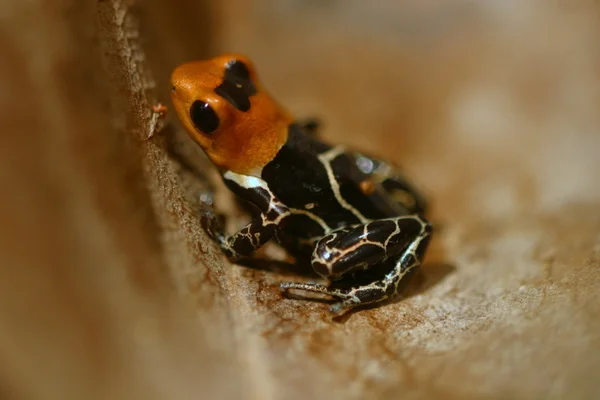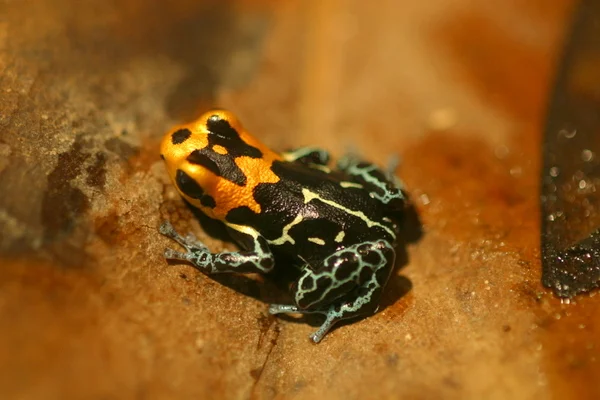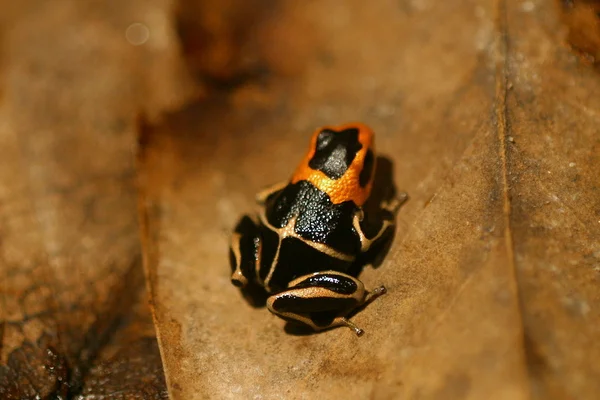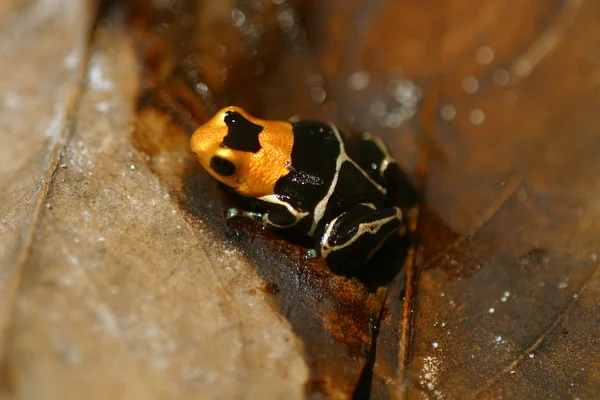
























Your Custom Text Here
Ranitomeya fantastica is one of the larger species of thumbnails with some females reaching an inch in length. The species is extremely variable across its entire range and fully deserving of the species name fantastica. The bright orange heads of the ones from Varadero and the orange head offset by the cream neck band on the holotype frogs from Yurimaguas are particularly striking.
Like R. benedicta, courting is initiated by the male with a buzzing call similar to R. variabilis but repeated for 5 to 10 seconds. The call can be heard easily outside the enclosure. If interested the female will follow the male around the enclosure, walking in a jerky fashion and stroking his back. These frogs lay 3 to 8 light gray eggs every 10 to 14 days on horizontal surfaces, often showing preference for overlapping leaves on short plants or in the leaf litter. Our frogs lay in film canisters, and prefer ones that are black, mounted amongst leaves with the opening facing the rear of the enclosure. The male will transport tads, frequently 2-3 at a time to water, including film canisters.
Care: Intermediate, large as adults but rocket fast, sometimes shy
Groups: Yes, male heavy
Breeding: Easy - Moderate, horizontal film canisters on their sides or in the leaf litter, sometimes leaflitter used exclusively
Tadpoles: No parental care after deposition, recommend pulling after deposition
Froglets: Small - Medium, springtails are a help
Tips: It can be hard to find eggs. Sometimes it's best to provide plenty of deposition sites and just pull tads. Try placing film canisters at the back of the enclosure with just a small gap between the opening and the back of the vivarium.
Ranitomeya fantastica is one of the larger species of thumbnails with some females reaching an inch in length. The species is extremely variable across its entire range and fully deserving of the species name fantastica. The bright orange heads of the ones from Varadero and the orange head offset by the cream neck band on the holotype frogs from Yurimaguas are particularly striking.
Like R. benedicta, courting is initiated by the male with a buzzing call similar to R. variabilis but repeated for 5 to 10 seconds. The call can be heard easily outside the enclosure. If interested the female will follow the male around the enclosure, walking in a jerky fashion and stroking his back. These frogs lay 3 to 8 light gray eggs every 10 to 14 days on horizontal surfaces, often showing preference for overlapping leaves on short plants or in the leaf litter. Our frogs lay in film canisters, and prefer ones that are black, mounted amongst leaves with the opening facing the rear of the enclosure. The male will transport tads, frequently 2-3 at a time to water, including film canisters.
Care: Intermediate, large as adults but rocket fast, sometimes shy
Groups: Yes, male heavy
Breeding: Easy - Moderate, horizontal film canisters on their sides or in the leaf litter, sometimes leaflitter used exclusively
Tadpoles: No parental care after deposition, recommend pulling after deposition
Froglets: Small - Medium, springtails are a help
Tips: It can be hard to find eggs. Sometimes it's best to provide plenty of deposition sites and just pull tads. Try placing film canisters at the back of the enclosure with just a small gap between the opening and the back of the vivarium.
Caynarachi Valley
The Caynarachi Valley morph enter the US hobby through Understory Enterprises. Likely coming from a higher elevation that the Copperhead lines already in the hobby, these frogs were also our first taste of fantastica with solid orange heads. While the majority of the frogs have some sort of butterfly or crown pattern, some are produced with solid orange heads.
Caynarachi Valley
Copperhead
These frogs are from an old line from Europe which came to the US in the late 1990's. Generally shy, our frogs are especially bold; bolder than some of our imitators. Even shy frogs can become more bold when breeding. These frogs likely originate between the collection locations for Understory's Caynarachi Valley and Lowland fantastica morphs - probably where INIBICO collected their frogs.
These frogs should not be mixed in captivity.
Copperhead
Copperhead
Copperhead
Copperhead
Copperhead
Copperhead
INIBICO
These frogs were imported through the INIBICO project and have collection site information associated with them. They are likely the natural integrade between the Lowland and Caynarachi Valley morphs that Understory imported - and possibly from the same locale as the old line Copperhead morph. The extreme variability of the INIBICO morph makes it special.
These frogs should not be mixed with Copperheads in captivity.
INIBICO
INIBICO
INIBICO
INIBICO
Lowland
'Lowland' frogs tend to be more variable patternwise than the 'Copperhead' morph, with some frogs' crowns being replaced by a more R. variabilis like dot and Y pattern. These frogs can be reclusive in general, but become far more bold when actively courting. Mine appear to prefer breeding in the leaf litter and film canisters on the floor of the enclosure instead of horizontal leaves like the 'Copperhead' do.
Lowland
Lowland
Lowland
White Banded
These fantastica from Tarapoto, Peru are the product of Understory's work. The frogs have a bright orange head with a well defined star or crown. The back pattern consists of moderately narrow white to peach to yellow colored summersi-like bands on a black background. The similarities to summersi do lend credence to the anecdotes that this frog is a natural (or accidental man-made in the wild) hybrid of the two species.
INIBICO also sent frogs to the US however, the numbers were limited and they did not breed well. To my knowledge there is only one female left in captivity.
White Banded
White Banded
White Banded
White Banded
White Banded